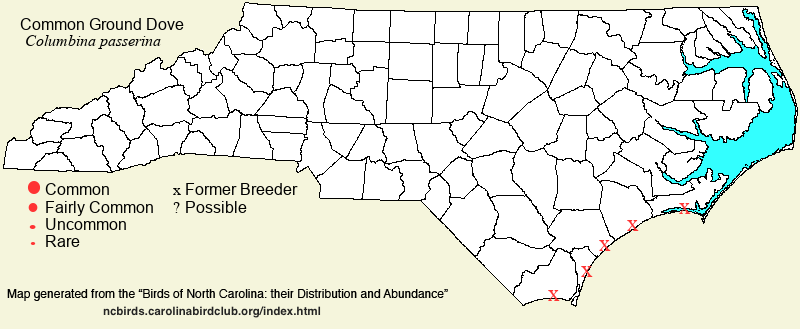 |  |
|
Common Ground Dove - Columbina passerina COLUMBIDAE Members: | Search Common: Search Scientific: |
|
|
||||||
| General Comments |
The Common Ground Dove is one of the few species that North Carolina has lost as a breeder in the past few decades. However, historically, the species was numerous northward only to South Carolina. In the 1960's and 1970's, small numbers bred along the immediate coast (mainly on islands) northward to Carteret. Sadly, since about 1980, no such breeding has taken place, and now there are only occasional sightings coastally and elsewhere (none from 2007 - 2010). Factors in the decline likely involve a combination of predation by cats and perhaps other mammals, losses of eggs and nestlings to fire ants, and continued habitat loss of maritime thickets to development. However, the species is confiding, and typically nests near man; thus, the species often fares well in lightly settled coastal areas. When it was resident in North Carolina, the species was generally found in sandy areas close to vegetation, such as margins of maritime forests and thickets, dunes, and coastal yards. Elsewhere, strays can appear most anywhere in open country, but usually where sandy and with some cover.
Note that the hyphen between the words "Ground" and "Dove" was removed in June 2019 by the AOS (American Ornithological Society). | |||||
| Breeding Status | Former Breeder | |||||
| NC BRC List | Definitive | |||||
| State Status | SR | |||||
| U.S. Status | ||||||
| State Rank | SXB | |||||
| Global Rank | G5 | |||||
| Coastal Plain | Formerly a permanent resident along the southern coast. At the present time (2023), a very rare to rare visitor along the southern coast, and casual to very rare visitor elsewhere, including far inland (though no far inland records in the southwestern portions, including the Sandhills). Formerly, rare to uncommon breeder along the coast, north to Carteret, until around 1980. Occurs mostly in the warmer months, from Mar to Dec. One photographed in Bladen on 27 Jan 2018 was an extremely rare mid-winter record so far inland. Peak counts: a report of 10-15 on 11 May 1941 at Knotts Island (Currituck) is remarkable, if correct, as this site is practically in Virginia. "Lots" (no number given) at a feeder at Topsail Beach in winter 1985-86; 4, 23 Dec 1972, West Onslow Beach. | |||||
| Piedmont | Casual to very rare visitor, with about 10 records. Records are for Raleigh, Jordan Lake, Falls Lake, Guilford, North Wilkesboro, Richfield (Stanly), Charlotte, Rutherford, and Pee Dee NWR (Richmond), all of single birds. Only two are in spring -- 3 May 1999 (Falls Lake) and 4-6 May 2024 (Pee Dee NWR); the others are from 18 Aug to 18 Nov, except for one at Richfield in midwinter -- photographed under a feeder on 13 Feb 2014. | |||||
| Mountains | Casual stray, with four records: 1 collected at Weaverville on 29 May 1891; 1 seen at Fairview (Buncombe) on 31 Oct 1984; 1 seen and photographed in 25 Jun - 9 Jul 2006, in Mills River Valley (Henderson); and 1 photographed at the last location on 17-19 Nov 2014 (for a remarkable coincidence). | |||||
| Finding Tips |
Currently, one must luck into one, or (of course) chase someone else's find. * | |||||
| Attribution | LeGrand[2024-08-02], LeGrand[2023-03-03], LeGrand[2023-02-25] | |||||
| NC Map Map depicts all counties with a report (transient or resident) for the species. | Click on county for list of all known species. |
| NC Breeding Season Map Map depicts assumed breeding season abundance for the species. |  |